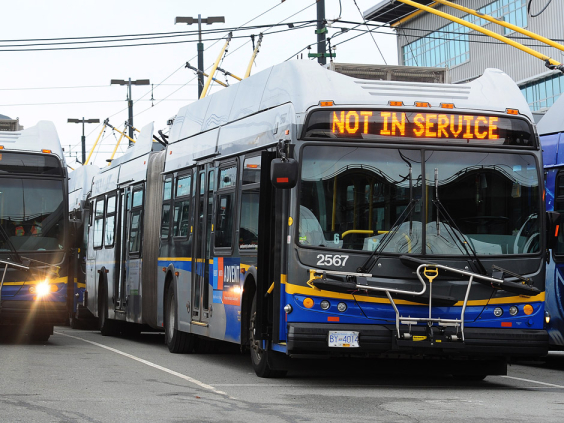Opening Statement
Efficient transportation is key for building economic and environmental sustainability. Currently, transportation infrastructure and traffic congestion are major economic issues in BC’s large urban centres as they create barriers and delays for employees getting to work, adversely impacting employers business operations.
There is a need for alternative transportation options to facilitate employees’ commutes. Cycling, including e-bikes, provide viable alternatives for employees in commuting and general transportation. There are multiple barriers to using bicycles and e-bikes in BC’s large urban centres principally, especially for commuting. These core barriers are related to concerns with the costs, convenience and comfort, infrastructure, lack of cycling facilities, and safety and security. Mitigating these barriers to cycling will allow for cycling to be a more accessible option in travel, and provide economic, environmental, and health benefits.
Background
Active transportation as a mode of commuting is fast-growing. From 1996 to 2016, the number of people cycling to work increased by 87.9%, far in excess of the overall growth in the number of commuters.1 Specifically, 182,015 British Columbians use active transportation as their main mode of commuting to work.2 Active transportation is considered either walking or cycling, with the latter being more common.
Along with regular pedal bikes, electric bikes (e-bikes) are gaining in popularity and encouraging more people to ride. An e-bike is a two- or three-wheeled cycle with an electric motor (up to 500 watts). Ebikes allow riders to go further with less effort, thus extending the range and terrain people are willing to ride; opening up the option of cycling to work to a broader population.
Many employees are willing to ride to work, but studies conducted by the North Vancouver Chamber have identified that many are facing barriers in using cycling as a mode of transportation. The core issues, which act as barriers to cycling or e-biking are:
- Purchase Price: Bicycles, and especially e-bikes, can be expensive. While costs have com down over time, e-bikes remain expensive and are not yet affordable for everyone. Reducing this purchasing barrier will support e-bike adoption.
- Fear of Theft: Given the value of an e-bike or regular bike, there are also the concerns of theft of the bicycles, e-bikes, and their batteries due to a lack of secure bike parking facilities. Increased secure storage areas and anti-theft initiatives will help mitigate these concerns and risks
- Lack of Available and Safe Infrastructure: While some communities have designated bike lanes or pathways, many still don’t. Investing in measures to support safety and connectivity on roadways, bridges, and through neighbourhoods is critical to further adoption of cycling or ebiking to work.
Although the Province has continued to invest in cycling infrastructure, more eeds to be done to support the use of bicycles and e-bikes in BC. Indeed, increased use of e-bikes will allow for greater return on those investments. Furthermore, options to encourage e-bikes will also complement other efforts in promoting cycling in general.
First, cycling can play an increasingly significant role in policies to promote low carbon transport and healthy cities.3 Cycling can help reduce traffic congestion and the wear and tear on vehicle road infrastructure. In addition, e-bikes can substitute journeys by car that are deemed too challenging for conventional pedal cycling due to distance and topography. Furthermore, as cycling allows for access to clean-energy transportation, funding for some of the options can come from the CleanBC Communities Fund.
Second, cycling can make an important contribution to promoting wellbeing through independent travel. Promoting cycling to work offers significant benefits; including health benefits associated with biking and regular exercise, associated decreased health care costs, improved productivity and reduced absenteeism.4 This further falls in line with most worksite wellness programs.
Third, cycling expands opportunities to engage in activities spread across wider geographical areas. Multiple studies indicate that cycling contributes probably more to the local economy than the use of other transport modes.5 Cyclists go more to local shops, restaurants, cafés or other local businesses than users of other transport modes, thereby increasing the retail turnover of local retailers.6 Cycling, including e-biking provides an option for people in commuting to work which would assist business owners to attract and retain employees.
Fourth, cycling can be a very effective way of bridging the ‘first mile, last mile’ gap, helping people connect to existing transit which may not be conveniently located to their residents. This improves modal shares of both active transportation and transit, and less reliance on automobiles.
Furthermore, it is recognized that the BikeBC program is providing support to cycling infrastructure projects. However, there could be additional improvements that could further benefit people who cycle to work. As such, in order to make cycling more accessible for employees, policies could be implemented to overcome the barriers of costs, practical inconveniences, and safety while commuting.
THE CHAMBER RECOMMENDS
That the Provincial Government reduce barriers to bike and e-bike adoption as a mode of workforce transportation in the following areas:
- Reduce Purchase Price Barriers:
- a. Remove PST Tax and provide rebates for the purchase of e-bikes;
- b. Increase the BC Scrap-It! Program rebate from $850 to $1500 when you scrap a car and buy an e-bike;
- c. Support and develop initiatives for employers and organizations to provide financial incentives to their employees to bicycle and e-bikes to work.
- Reduce Fear of Theft:
- a. Expand eligible proposals for BikeBC applications to include the implementation of end-oftrip amenities, charging stations, and secure parking facilities for bicycles and e-bikes;
- b. Continue and create new anti-bike theft programs;
- c. Expand availability of insurance for bikes including e-bikes.
- Improve Availability and Safety of Integrated Cycling Infrastructure:
- a. Increase support for separated bike paths, protected and connected bike lanes, include designated safe bike lanes on provincial roadways and bridges, and improved designed standards which can also safely accommodate e-bikes.
Submitted by the North Vancouver Chamber
Supported by Squamish Chamber of Commerce
1Statistics Canada, “Commuters using sustainable transportation in census metropolitan areas: Census of population, 2016,” 2017.
2Ibid.
3Jones, Tim, Lucas Harms, and Eva Heinen, “Motives, perceptions and experiences of electric bicycle owners and implications for health, wellbeing and mobility,” Journal of Transport Geography, 2016.
4 Tran, Molly, Linda Forst, and Susan Buchanan, “Not on the radar: active commuting as a workplace wellness issue,” Journal of Occupational and Environmental Medicine, 2015. Vairo, Nicole, Melissa Bopp, and Dangaia Sims, “Best practices for businesses promoting bicycling,” International Journal of Health Promotion and Education, 2017. Laverty, Anthony A., Jennifer S. Mindell, Elizabeth A. Webb, and Christopher Millett, “Active travel to work and cardiovascular risk factors in the United Kingdom,” American Journal of Preventive Medicine, 2013. Hamer, Mark, and Yoichi Chida, “Active commuting and cardiovascular risk: a meta-analytic review,” Preventive Medicine, 2008. Xu, Huilan, Li Ming Wen, and Chris Rissel, “The relationships between active transport to work or school and cardiovascular health or body weight: a systematic review,” Asia Pacific Journal of Public Health, 2013.
5 Blondiau, Thomas, Bruno Van Zeebroeck, and Holger Haubold, “Economic benefits of increased cycling,” Transportation Research Procedia, 2016. Clifton, Kelly, Kristina M. Currans, Christopher D. Muhs, Chloe Ritter, Sara Morrissey, and Collin Roughton, “Consumer behavior and travel choices: A focus on cyclists and pedestrians,” 2012. O’Connor, David, “Shopping Travel Behaviour in Dublin City Centre Survey,” 2012.
6 Kåstrup, Marie. “Are cyclists good customers,” Cycling Embassy Of Denmark, 2013. New York City Department of Transportation, “Measuring the Street: New Metrics for 21st Century Streets,” 2012.Submitted by the North Vancouver Chamber



